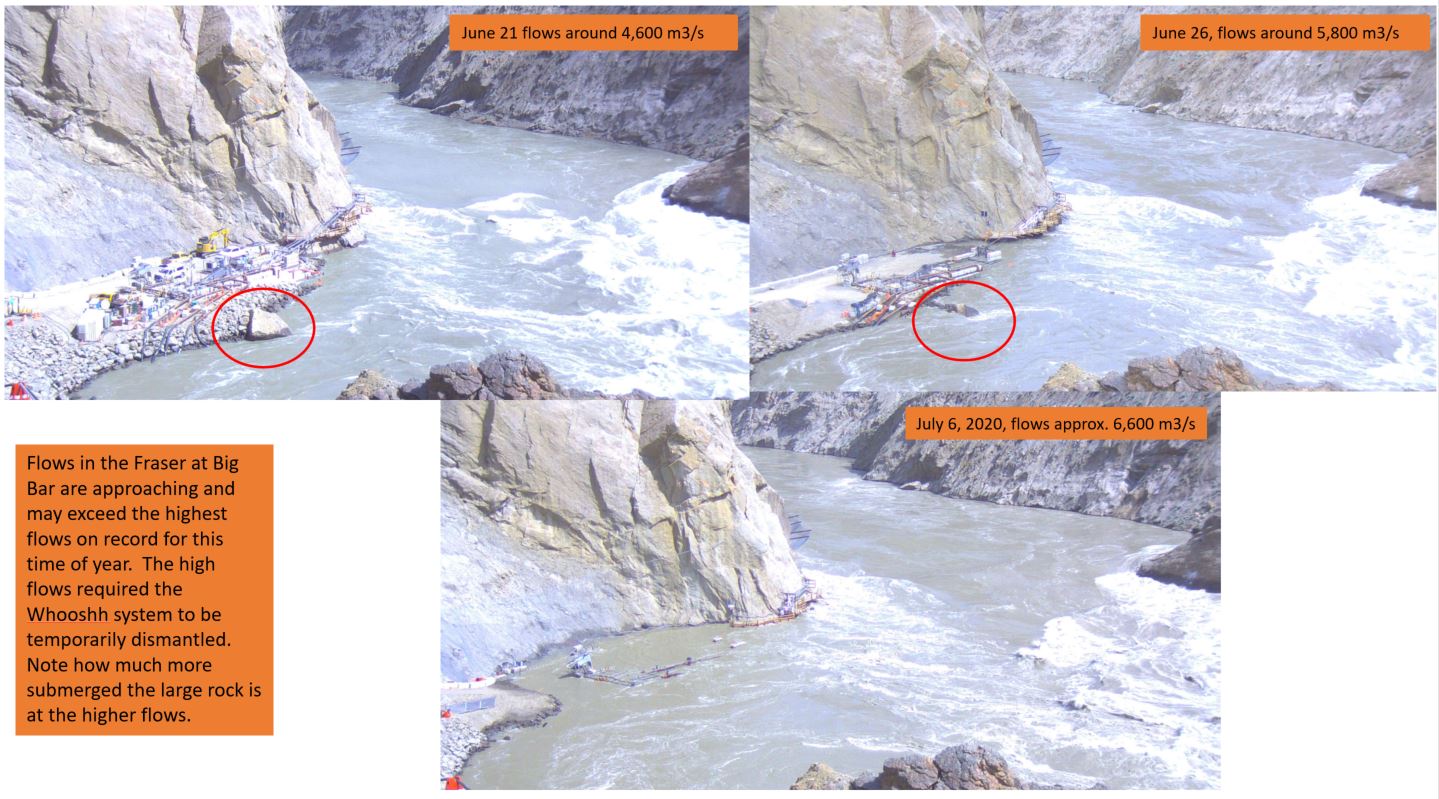You are using an out of date browser. It may not display this or other websites correctly.
You should upgrade or use an alternative browser.
You should upgrade or use an alternative browser.
Rock slide in Fraser River, B.C., may hinder salmon passage
- Thread starter wildmanyeah
- Start date
You would think since they are closing the Chinook Fishery down that perhaps people might actually appreciate some numbers but for the $200 million already spent we get zero numbers. Are there no fish passing or pooling at the slide site and if so then report that?High water/Albion= Useless
They also arent saying how many they.are losing to seals each set right now!
tincan
Well-Known Member
Chinook have been starting to show up at the slide site and just south. A few chinook (6) have passed the slide site naturally and were detected 40km north of the slide. These 6 chinook were part of the 50 chinook that had been radio tagged as of a few days ago. They plan to radio tag around 500 chinook and 500 sockeye this year. Hopefully a lot more chinook start showing up soon so they can test out the salmon cannon as the water levels now won't be permitted much natural passage in all likelihood.
donnie d
Well-Known Member
So a few Chinook have passed the slide on their own steam. Water levels +5000m3/sec seem quite higher than this time last year. that had to be a positive sign that the winter work on widening the channel and making the “natural fish ladder” have been fairly successful given the challenges of course.
when the water comes down below 3000m3/sec hopefully no transport or mechanized assistance is required.
I do kind of want to see a video of the whoosh system in action though!
when the water comes down below 3000m3/sec hopefully no transport or mechanized assistance is required.
I do kind of want to see a video of the whoosh system in action though!
GLG
Well-Known Member
Big Bar landslide response information bulletin
June 26 2020
Ongoing onsite operations
This week marked two key milestones on the Big Bar landslide response efforts:
To date, approximately 50 fish, all chinook, have been radio tagged. The Churn Creek sonar station, located 40 km upstream of the slide site, detected seven fish thus far. Preliminary data suggests they likely migrated naturally past the slide site around June 14 when water levels dropped to 4,000 cms. The current Fraser River flow rate at the Big Bar ferry is approximately 6,070 cms.
What is a fish wheel and how does it work?
Emulating the traditional First Nations fishing method of dip-netting, fish wheels are effective in various water levels and conditions due to their mobility and adjustability. While the “nature-like” fishway and the Whooshh Passage Portal remain the primary methods to transport salmon over the slide, this supplementary technology will support tagging activities and, if required, collect fish for ‘truck and transport’.
With mechanics similar to a watermill, the fish wheel is a selective harvest mechanism outfitted with framed baskets to trap, carry and direct fish into live holding tanks. The flow of natural river water through the holding tanks maintains a constant oxygen supply for the salmon. This device can be also be designed and modified based on the location it will be operating.
A First Nations crew was onsite last week to assemble the device. Over the weekend, the unit was positioned to float on pontoons and is now operational. Fish will be caught in the baskets and carried to bins where a team of First Nations and DFO fisheries technicians will swiftly radio tag each one before release back into the Fraser River. This technology will also allow the team to collect high priority chinook for ‘truck and transport’ to the French Bar Creek holding facility. The team will refine the fish wheel throughout the summer to ensure its effective operation.
Recognizing our Indigenous partners – today and everyday
June 21 is National Indigenous Peoples Day. Recognition of this day is especially significant when reflecting on the work over the last year on the Big Bar landslide because of the important contributions of Indigenous Peoples.
Since the initial reporting of the slide on June 23, 2019, the response effort has shared an intimate and interdependent relationship with the region’s First Nations communities. The landslide occurred on the traditional territories of High Bar First Nation (HBFN), Stswecem’c Xgat’tem First Nation (SXFN) and St’at’imc Nation. These First Nations, as well as many others, have been involved from the outset with the slide response and remain an integral part of the planning, operations, communications and decision-making processes today.
Direct First Nations involvement on the response continues through: the Joint Executive Steering Committee (JESC); the First Nations Leadership Panel (FNLP), which guides the First Nations JESC representatives; and, the Upper Fraser Fisheries Conservation Alliance (UFFCA), which provides oversight and support to a series of initiatives occurring in the Upper Fraser in response to slide.
In addition, the Fraser Salmon Management Council (FSMC) manages First Nations contracts and administers the Indigenous engagement support funds, provides oversight of the project team and communications, and leads the First Nations engagement group.
In the field, St’at’imc Eco-Resources is the First Nations liaison and project coordinator for fisheries associated activities. Splitrock Environmental provides technicians and developed an environmental monitoring plan. HBFN leads the archaeological work and other activities with SXFN, which also provides safety and security services upstream for the sonar monitoring activities. Both Nations remain key participants in the work underway and are members of the JESC.
The Big Bar Landslide Response team would like to thank the numerous Indigenous fish technicians, firefighters, scientists, safety officers, contractors, administrators, project managers, project directors, executives and leaders who contributed to the response effort over the last year. As work proceeds to restore sustainable, full passage at the slide site, we look forward to continuing this collaboration with our First Nations partners and the Government of British Columbia.
Current images of work being done at the landslide site
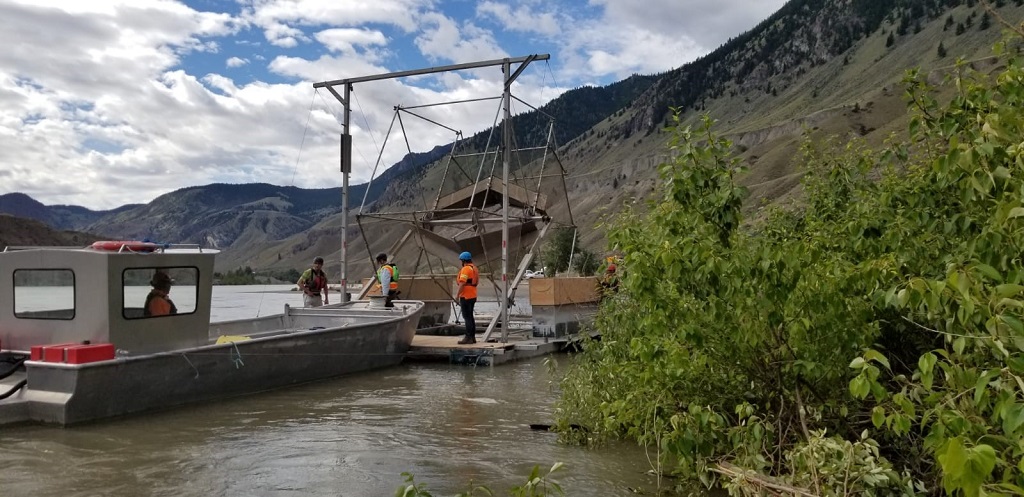
The fish wheel was floated into position this week downstream of the slide site, on the left side of the river.
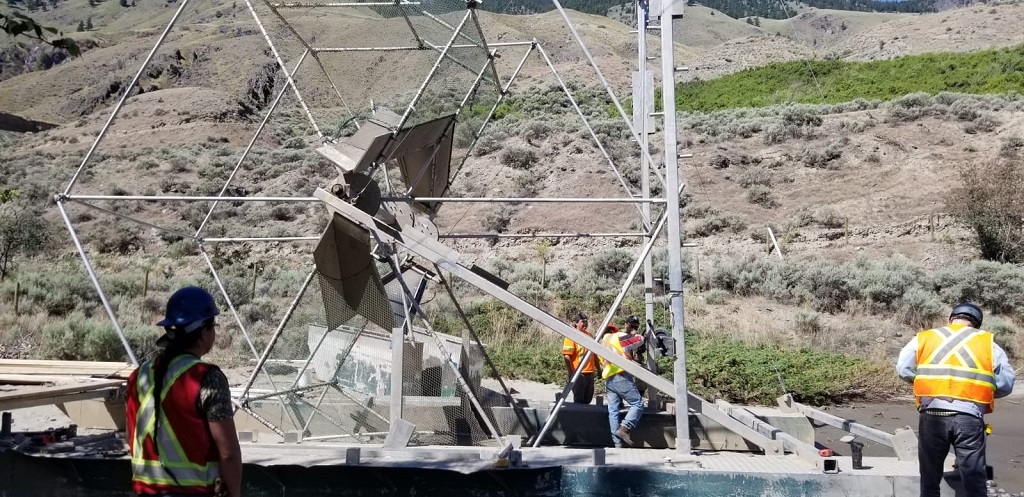
A side profile of the fish wheel.

An overhead shot of the concrete fish ladder and the Whooshh Passage Portal, which was completed this week.
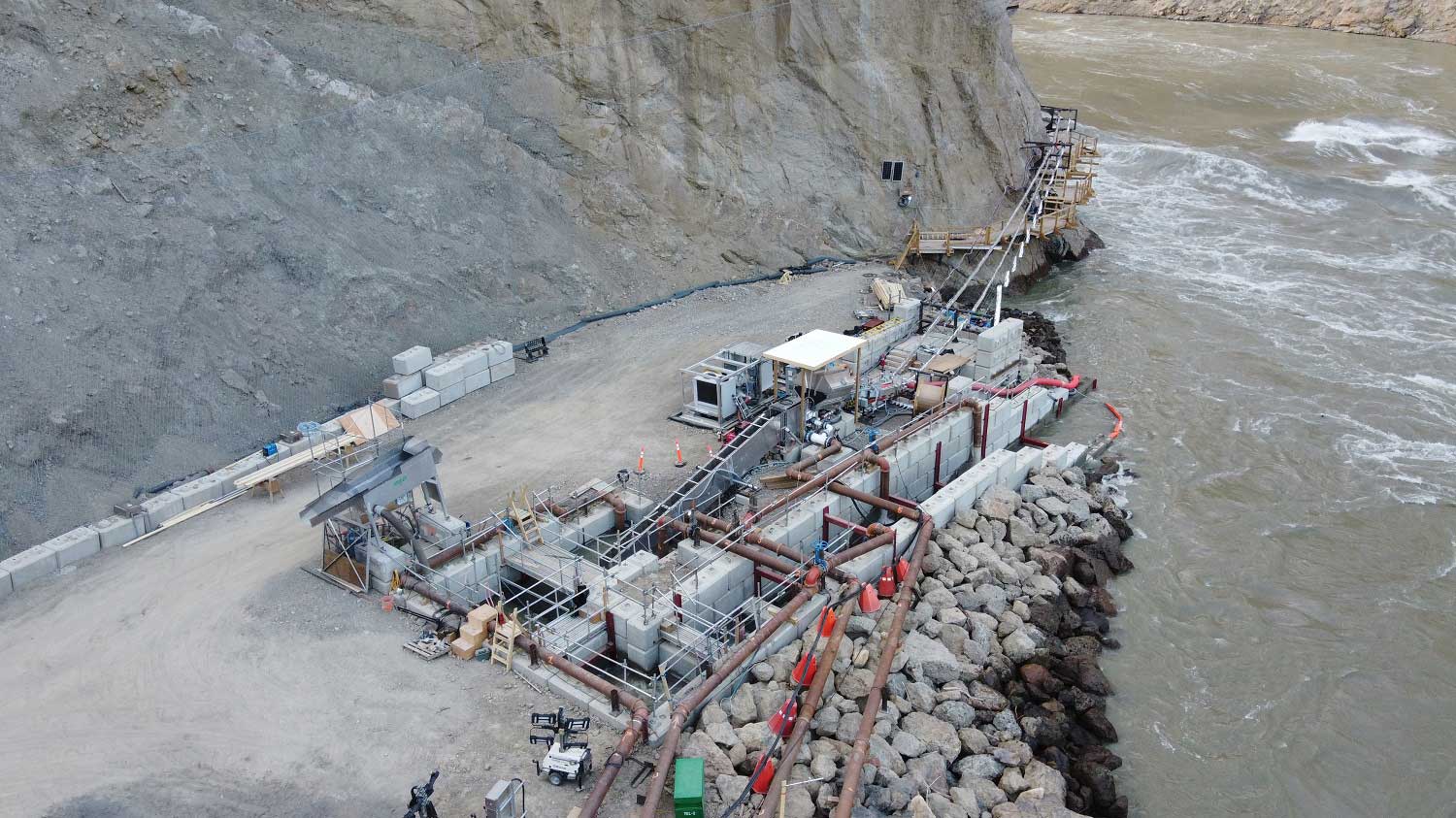
A side view of the fishway and the Whooshh Passage Portal, with tubes running at the top of the photo.
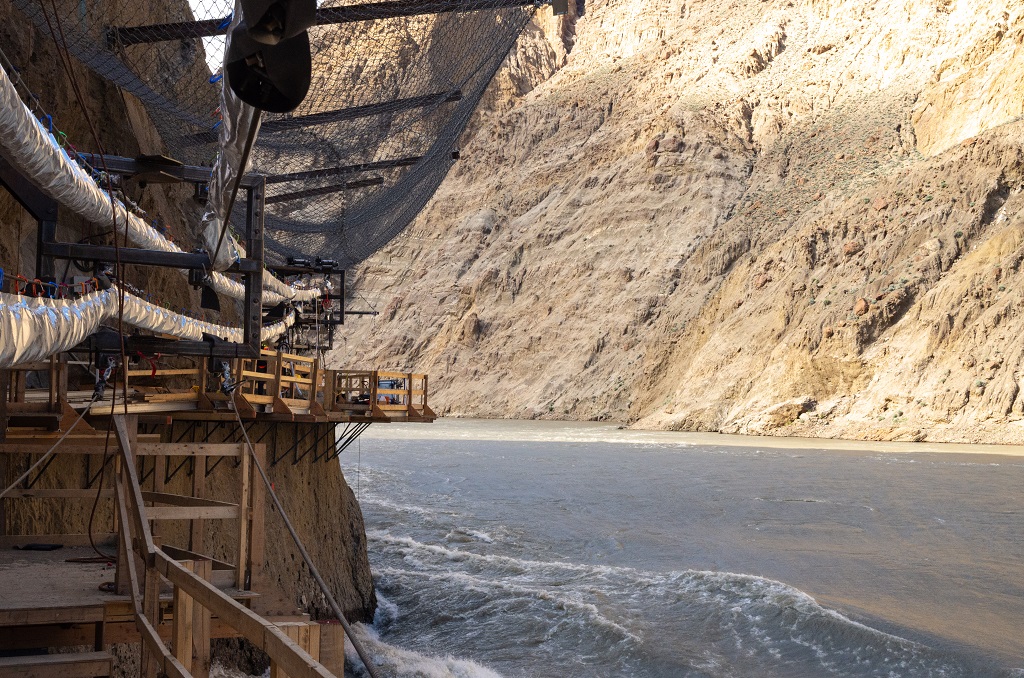
The tubes for the Whooshh Passage Portal are suspended above the working platform on secure hangers attached to the canyon wall.
https://www.pac.dfo-mpo.gc.ca/pacif...landslide-eboulement/bulletins/index-eng.html
June 26 2020
Ongoing onsite operations
This week marked two key milestones on the Big Bar landslide response efforts:
- As of June 21, the Whooshh Passage Portal is operational.
The prime contractor, Peter Kiewit Sons ULC, completed work this past weekend on the installation of the remaining Whooshh system components. All tubes were fed through to the termination hanger, and the system underwent extensive testing over the week. No fish have been transported through the system to date as few have arrived at the site. This two-tube system will be replaced with a higher capacity six-tube system in July. - On June 21, the initial salmon – a male and a female chinook – were captured within the concrete fish ladder.
Both salmon were then transported by truck to the French Bar Creek holding facility for radio tagging and DNA sampling. They will be kept there until genetic sample results determine if they should serve as broodstock, providing eggs and milt for fertilization, or released to continue their migration. To ensure fish health, modifications are being made to improve flow conditions and manage sediment accumulation in the concrete fish ladder.
To date, approximately 50 fish, all chinook, have been radio tagged. The Churn Creek sonar station, located 40 km upstream of the slide site, detected seven fish thus far. Preliminary data suggests they likely migrated naturally past the slide site around June 14 when water levels dropped to 4,000 cms. The current Fraser River flow rate at the Big Bar ferry is approximately 6,070 cms.
What is a fish wheel and how does it work?
Emulating the traditional First Nations fishing method of dip-netting, fish wheels are effective in various water levels and conditions due to their mobility and adjustability. While the “nature-like” fishway and the Whooshh Passage Portal remain the primary methods to transport salmon over the slide, this supplementary technology will support tagging activities and, if required, collect fish for ‘truck and transport’.
With mechanics similar to a watermill, the fish wheel is a selective harvest mechanism outfitted with framed baskets to trap, carry and direct fish into live holding tanks. The flow of natural river water through the holding tanks maintains a constant oxygen supply for the salmon. This device can be also be designed and modified based on the location it will be operating.
A First Nations crew was onsite last week to assemble the device. Over the weekend, the unit was positioned to float on pontoons and is now operational. Fish will be caught in the baskets and carried to bins where a team of First Nations and DFO fisheries technicians will swiftly radio tag each one before release back into the Fraser River. This technology will also allow the team to collect high priority chinook for ‘truck and transport’ to the French Bar Creek holding facility. The team will refine the fish wheel throughout the summer to ensure its effective operation.
Recognizing our Indigenous partners – today and everyday
June 21 is National Indigenous Peoples Day. Recognition of this day is especially significant when reflecting on the work over the last year on the Big Bar landslide because of the important contributions of Indigenous Peoples.
Since the initial reporting of the slide on June 23, 2019, the response effort has shared an intimate and interdependent relationship with the region’s First Nations communities. The landslide occurred on the traditional territories of High Bar First Nation (HBFN), Stswecem’c Xgat’tem First Nation (SXFN) and St’at’imc Nation. These First Nations, as well as many others, have been involved from the outset with the slide response and remain an integral part of the planning, operations, communications and decision-making processes today.
Direct First Nations involvement on the response continues through: the Joint Executive Steering Committee (JESC); the First Nations Leadership Panel (FNLP), which guides the First Nations JESC representatives; and, the Upper Fraser Fisheries Conservation Alliance (UFFCA), which provides oversight and support to a series of initiatives occurring in the Upper Fraser in response to slide.
In addition, the Fraser Salmon Management Council (FSMC) manages First Nations contracts and administers the Indigenous engagement support funds, provides oversight of the project team and communications, and leads the First Nations engagement group.
In the field, St’at’imc Eco-Resources is the First Nations liaison and project coordinator for fisheries associated activities. Splitrock Environmental provides technicians and developed an environmental monitoring plan. HBFN leads the archaeological work and other activities with SXFN, which also provides safety and security services upstream for the sonar monitoring activities. Both Nations remain key participants in the work underway and are members of the JESC.
The Big Bar Landslide Response team would like to thank the numerous Indigenous fish technicians, firefighters, scientists, safety officers, contractors, administrators, project managers, project directors, executives and leaders who contributed to the response effort over the last year. As work proceeds to restore sustainable, full passage at the slide site, we look forward to continuing this collaboration with our First Nations partners and the Government of British Columbia.
Current images of work being done at the landslide site

The fish wheel was floated into position this week downstream of the slide site, on the left side of the river.

A side profile of the fish wheel.
An overhead shot of the concrete fish ladder and the Whooshh Passage Portal, which was completed this week.

A side view of the fishway and the Whooshh Passage Portal, with tubes running at the top of the photo.
The tubes for the Whooshh Passage Portal are suspended above the working platform on secure hangers attached to the canyon wall.
https://www.pac.dfo-mpo.gc.ca/pacif...landslide-eboulement/bulletins/index-eng.html
cuttlefish
Well-Known Member
Awesome job getting this all in place. Also great news to hear some Chinook are getting past the slide on their own.
GLG
Well-Known Member
Big Bar landslide response information bulletin
July 3 2020
Ongoing onsite operations
This past week, work at the Big Bar landslide site was impacted by the high freshet flows from the region’s rapidly melting snow packs. On June 27 and June 28, onsite operations on the West Beach were temporarily suspended due to flooding conditions. Working under an abundance of caution, the project team implemented additional measures in anticipation of the forecasted high water levels.
Beginning June 25, crews relocated all sensitive equipment to higher ground to safeguard against damage. The equipment included components of the Whooshh Passage Portal™ system. However, before water levels increased, crews were able to carry out additional fine tuning of the Whooshh™ system. This work included the calibration of the fish tube sensors, testing, and installation of camera mounts where the fish exit the system.
The Province of BC’s River Forecast Centre is predicting Fraser River water flows at Big Bar will soon be the highest recorded this year. As high water levels continue to impact many river systems throughout British Columbia, the team is monitoring the situation. Activities at Big Bar will resume once water levels subside and site conditions are deemed safe. In the meantime, the team is adjusting their work accordingly.
Update on fish monitoring
The high water levels, velocities and sediment concentrations of the Fraser River are appearing to delay the 2020 spring chinook migration. Few fish have been observed over the past week by the hydroacoustic stations and the radio tagging program has applied very few new tags compared to previous weeks.
Additionally, fish wheel operations have been temporarily paused to protect the equipment and to ensure operator safety.
Enhancement program update
The two chinook captured on June 21 were moved to a hatchery facility in Vanderhoof on June 29, in advance of receiving the DNA results. This move was in anticipation of high water conditions potentially impacting the French Bar Creek Holding Facility. Identification and monitoring of these fish will be ongoing and results will be shared through future information bulletins.
Current images of work being done at the landslide site
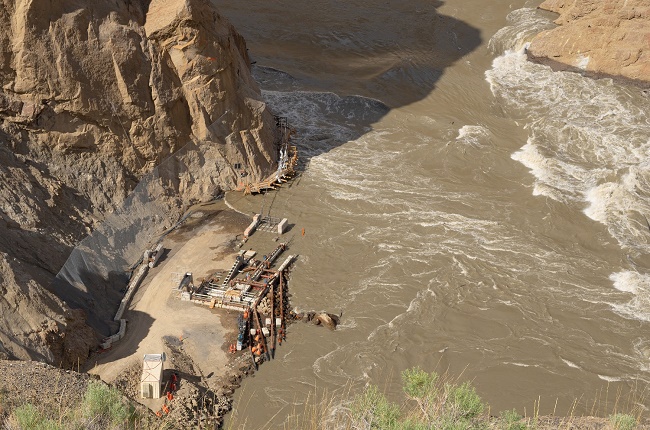
Aerial shot shows the high water levels at the Big Bar landslide site, as levels reach historic highs in much of British Columbia.
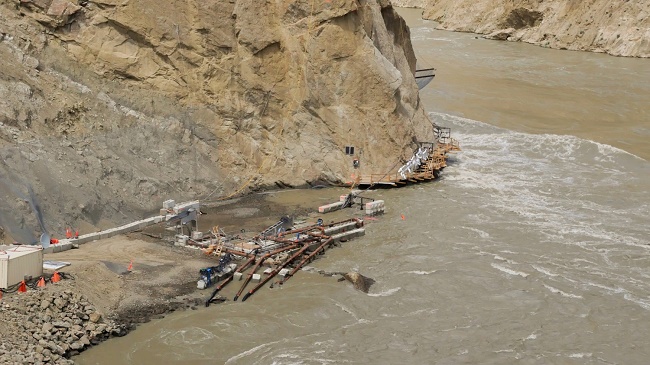
High water levels at the work site required the relocation of equipment to higher ground.
https://www.pac.dfo-mpo.gc.ca/pacif...landslide-eboulement/bulletins/index-eng.html
July 3 2020
Ongoing onsite operations
This past week, work at the Big Bar landslide site was impacted by the high freshet flows from the region’s rapidly melting snow packs. On June 27 and June 28, onsite operations on the West Beach were temporarily suspended due to flooding conditions. Working under an abundance of caution, the project team implemented additional measures in anticipation of the forecasted high water levels.
Beginning June 25, crews relocated all sensitive equipment to higher ground to safeguard against damage. The equipment included components of the Whooshh Passage Portal™ system. However, before water levels increased, crews were able to carry out additional fine tuning of the Whooshh™ system. This work included the calibration of the fish tube sensors, testing, and installation of camera mounts where the fish exit the system.
The Province of BC’s River Forecast Centre is predicting Fraser River water flows at Big Bar will soon be the highest recorded this year. As high water levels continue to impact many river systems throughout British Columbia, the team is monitoring the situation. Activities at Big Bar will resume once water levels subside and site conditions are deemed safe. In the meantime, the team is adjusting their work accordingly.
Update on fish monitoring
The high water levels, velocities and sediment concentrations of the Fraser River are appearing to delay the 2020 spring chinook migration. Few fish have been observed over the past week by the hydroacoustic stations and the radio tagging program has applied very few new tags compared to previous weeks.
Additionally, fish wheel operations have been temporarily paused to protect the equipment and to ensure operator safety.
Enhancement program update
The two chinook captured on June 21 were moved to a hatchery facility in Vanderhoof on June 29, in advance of receiving the DNA results. This move was in anticipation of high water conditions potentially impacting the French Bar Creek Holding Facility. Identification and monitoring of these fish will be ongoing and results will be shared through future information bulletins.
Current images of work being done at the landslide site

Aerial shot shows the high water levels at the Big Bar landslide site, as levels reach historic highs in much of British Columbia.

High water levels at the work site required the relocation of equipment to higher ground.
https://www.pac.dfo-mpo.gc.ca/pacif...landslide-eboulement/bulletins/index-eng.html
wildmanyeah
Crew Member
Thanks for posting the update, I was wondering if it was going to flood the site as last weeks update it looked like the site was pretty close to the water level
Hopefully all the hard work they did stays intact, hopefully their site does not fill with silt
Hopefully all the hard work they did stays intact, hopefully their site does not fill with silt
wildmanyeah
Crew Member
Not going to see many fish at the slide if they can't make it through hells gate. Poor early stuarts this is really the last thing they need to deal with.
Fraser River discharge at Hope
Critical Levels for Fish Passage through Fraser Canyon:


Fraser River discharge at Hope
Critical Levels for Fish Passage through Fraser Canyon:
- 7000 cms - Early signs of physiological stress evident
- 8000 cms - Difficultly in migration delaying migration time.
- 9000 cms - Barrier to migration through Hell's Gate.

Last edited:
Poppa Reelie
Well-Known Member
Nice work. Look forward to seeing the numbers later in season.
wildmanyeah
Crew Member
This post is going to be kinda depressing and frankly im surprised its not in the news. but RIP early stuart sockeye.
Since June 1 its been basically above 8000 cms with about a one week period where it dropped to 7000 cms, Explains why there been basically no fish at the big bar slide side. Back in the day when early stuart were harvested this would of been already all over the news. Guess when things are not on peoples plate no one cares. Also to put things in perspective by July 17th last year there we already radio tagging fish and a few days after that they were moving fish by helicopter. Many of the fish at that point to were allready colored up and exhausted. This year is another Disaster for early run fish.
https://wateroffice.ec.gc.ca/report...8&prm1=46&y1Max=&y1Min=&prm2=47&y2Max=&y2Min=

Fraser River discharge at Hope
Critical Levels for Fish Passage through Fraser Canyon:
7000 cms - Early signs of physiological stress evident
8000 cms - Difficultly in migration delaying migration time.
9000 cms - Barrier to migration through Hell's Gate.
http://www.psc.org/FRPWeb/Escapement/Sockeye_Escapement.pdf

http://www.psc.org/TestFish/Area29DGNsummary.PDF

For comparison to the 2016 brood year. The story is not the missing fraser chinook the story is the missing Fraser sockeye.

Since June 1 its been basically above 8000 cms with about a one week period where it dropped to 7000 cms, Explains why there been basically no fish at the big bar slide side. Back in the day when early stuart were harvested this would of been already all over the news. Guess when things are not on peoples plate no one cares. Also to put things in perspective by July 17th last year there we already radio tagging fish and a few days after that they were moving fish by helicopter. Many of the fish at that point to were allready colored up and exhausted. This year is another Disaster for early run fish.
https://wateroffice.ec.gc.ca/report...8&prm1=46&y1Max=&y1Min=&prm2=47&y2Max=&y2Min=

Fraser River discharge at Hope
Critical Levels for Fish Passage through Fraser Canyon:
7000 cms - Early signs of physiological stress evident
8000 cms - Difficultly in migration delaying migration time.
9000 cms - Barrier to migration through Hell's Gate.
http://www.psc.org/FRPWeb/Escapement/Sockeye_Escapement.pdf

http://www.psc.org/TestFish/Area29DGNsummary.PDF

For comparison to the 2016 brood year. The story is not the missing fraser chinook the story is the missing Fraser sockeye.

Good point points on this WMY, however with the shear magnitude of water right now in the lower Fraser. There is a lot of water for these lower river nets to be finding fish. Wait for the water to drop...then take a look at the numbers.
I’m sure some of the the upper choke posts and back eddies have been getting sockeye now for a few weeks. You post all these links but aren’t taking into the water conditions.
The early Stuart’s were done years ago, no planning or real help from DFO. To think we used to get our first Sockeye on the bars mid May....sad.
Your reference to fish not being at the slide, are you talking Chinook or Sockeye?
I’m sure some of the the upper choke posts and back eddies have been getting sockeye now for a few weeks. You post all these links but aren’t taking into the water conditions.
The early Stuart’s were done years ago, no planning or real help from DFO. To think we used to get our first Sockeye on the bars mid May....sad.
Your reference to fish not being at the slide, are you talking Chinook or Sockeye?
wildmanyeah
Crew Member
Your reference to fish not being at the slide, are you talking Chinook or Sockeye?
I am only speaking to the data that's been provided. To date im not aware of any sockeye being captured at the Big bar slide. I know that a number of chinook have been captured and tagged. That said im sure a number of sockeye have passed as well but i don't see it being a large number. I have commented on the water conditions in another post but I have not directly talked about it in this one. You are right the sockeye are probably traveling close to shore and avoiding these drift test nets and perhaps the hydroacoustic is also **** because of the high flows and dirty water.
That said it looks to me and my interpretation that this year is going to be another dizaster year for early stuart sockeye. A very strong reason for why there should be no gillnet openings on the fraser.
I can't add everything to these posts I don't have that kind of time so I welcome any commentary on it.
wildmanyeah
Crew Member
Just thought I would add this, Its from last years notice but it shows how drastically different the flows were Last year it was 4.5k cms this year its above 10k on this date. The average for this date is between 5k and 6k.
"On July 8 the discharge of the Fraser River at Hope was 4,473 cms, which is approximately 23% below average for this date. The temperature of the Fraser River at Qualark Creek on July 8 was 16.20C, which is 0.7 0C higher than average for this date. Fraser River discharge levels and water temperatures will be monitored closely to determine if specific management actions are required during the in-river migratory period to help achieve Sockeye escapement goals."
"On July 8 the discharge of the Fraser River at Hope was 4,473 cms, which is approximately 23% below average for this date. The temperature of the Fraser River at Qualark Creek on July 8 was 16.20C, which is 0.7 0C higher than average for this date. Fraser River discharge levels and water temperatures will be monitored closely to determine if specific management actions are required during the in-river migratory period to help achieve Sockeye escapement goals."
wildmanyeah
Crew Member
Wow, going to be a few barren rivers again. 2 lost cycles ... is there any way these stocks can possibly be recovered?
Define recovered?
Similar threads
- Replies
- 8
- Views
- 772
- Replies
- 0
- Views
- 330
- Replies
- 3
- Views
- 1K
- Replies
- 0
- Views
- 751

